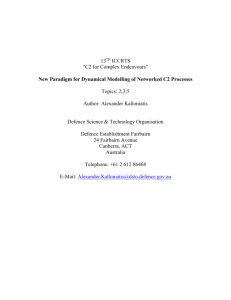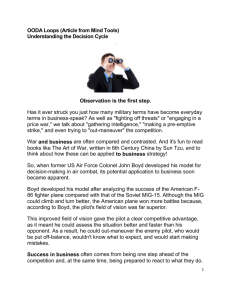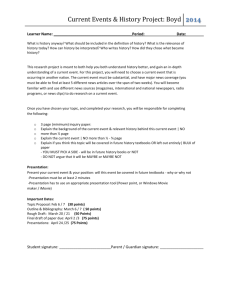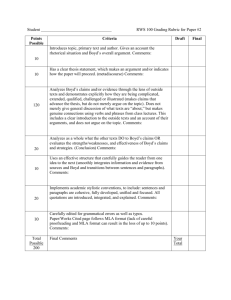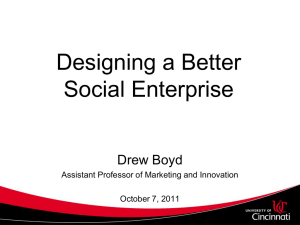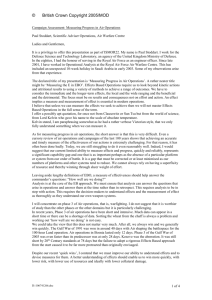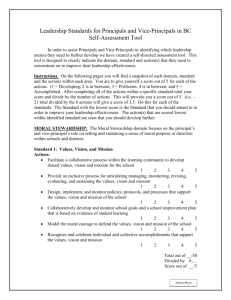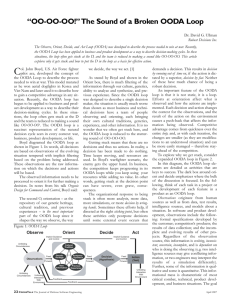original MS Word document
advertisement
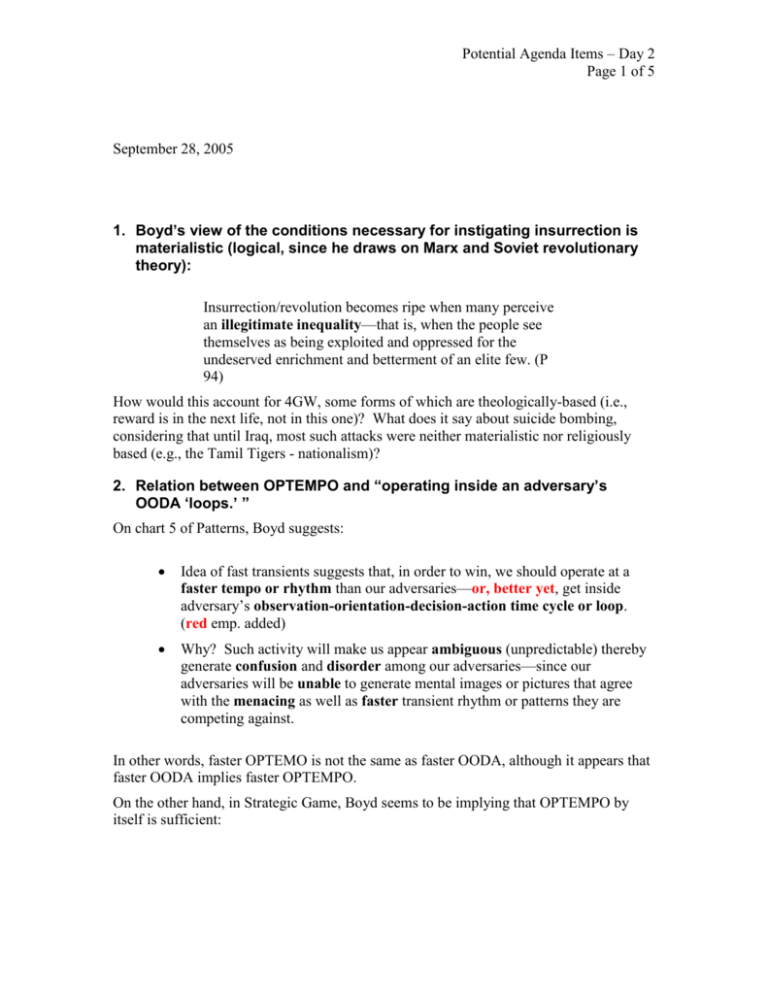
Potential Agenda Items – Day 2 Page 1 of 5 September 28, 2005 1. Boyd’s view of the conditions necessary for instigating insurrection is materialistic (logical, since he draws on Marx and Soviet revolutionary theory): Insurrection/revolution becomes ripe when many perceive an illegitimate inequality—that is, when the people see themselves as being exploited and oppressed for the undeserved enrichment and betterment of an elite few. (P 94) How would this account for 4GW, some forms of which are theologically-based (i.e., reward is in the next life, not in this one)? What does it say about suicide bombing, considering that until Iraq, most such attacks were neither materialistic nor religiously based (e.g., the Tamil Tigers - nationalism)? 2. Relation between OPTEMPO and “operating inside an adversary’s OODA ‘loops.’ ” On chart 5 of Patterns, Boyd suggests: Idea of fast transients suggests that, in order to win, we should operate at a faster tempo or rhythm than our adversaries—or, better yet, get inside adversary’s observation-orientation-decision-action time cycle or loop. (red emp. added) Why? Such activity will make us appear ambiguous (unpredictable) thereby generate confusion and disorder among our adversaries—since our adversaries will be unable to generate mental images or pictures that agree with the menacing as well as faster transient rhythm or patterns they are competing against. In other words, faster OPTEMO is not the same as faster OODA, although it appears that faster OODA implies faster OPTEMPO. On the other hand, in Strategic Game, Boyd seems to be implying that OPTEMPO by itself is sufficient: Potential Agenda Items – Day 2 Page 2 of 5 So, what’s with “inside the OODA ‘loop’ ” that’s not implied by faster OPTEMPO, at least as far as affecting the outcome of conflict goes? The reason (or at least one reason) this is important is that it is difficult to reconcile faster OPTEMPO with the O to O to D to A conception of the OODA loop, where we could only change actions once per cycle. Boyd’s OODA “loop” sketch, however handles this just fine, since it decouples OPTEMPO (defined as the rate at which we can change our actions) from the time it takes to go from Observation to Orientation to Decision to Action. 3. Anybody want to comment on the boxes inside “Orientation”? 4. Information Gathering Group think and destructive vs. adaptive filters. Discounting based in orientation reduces resources and thus capacity to act. It is therefore essential to build in subsystems that seek out contrary information and systems that challenge orientation. Boyd raises this, briefly in Organic Design, 28-29. 5. Recognizing The Tacit If the orientation is not known then the system is vulnerable. Another approach is to make the orientation known (not hidden) and this needs to be separate from the other tasks. This is the values, philosophy and importantly, the hidden rules of operation that can be seen when actors in the system influence behavior inconsistent with tacit rules (boundary violation recognition). Potential Agenda Items – Day 2 Page 3 of 5 6. Is there a role for the OODA “loop” in grand strategy and setting the national goal? Chart 142 of Patterns notes how everything below Strategic Aim is destructive in nature, while grand strategy and national goal are constructive. If you examine chart 141, however, you will note that the OODA loop is confined to the destructive elements, particularly to grand tactics and below. However, on chart 177, Boyd notes that: Simultaneously—by repeatedly rolling-thru O-O-D-A loops while appealing to and making use of the ideas embodied in “Grand Strategy” and “Theme for Vitality and Growth”—we can: Evolve and exploit Insight/Initiative/Adaptability/Harmony [note: which he later changed to Insight/Orientation/Harmony/Agility/Initiative] as basis to: Shape or influence events so that we not only amplify our spirit and strength (while isolating our adversaries and undermining their resolve and drive) but also influence the uncommitted or potential adversaries so that they are drawn toward our philosophy and are empathetic toward our success. So somehow he’s tying OODA loops to the constructive elements of the “Pattern for Successful Operations” and even to the grander “Theme for Vitality and Growth.” Theme for vitality and growth Unifying v ision A grand ideal, overarching theme, or noble philosophy that represents a coherent paradigm within which individuals as well as societies can shape and adapt to unfolding circumstances Ń yet offers a way to expose flaws of competing or adversary systems. Aim Improve fitness as an organic whole to shape and expand influence or power over the course of events in the world Ingredients needed to pursue vision Insight Ability to peer into and discern the inner nature or workings of things. Initiative Internal drive to think and take action without being urged. Agility Power to adjust or change in order to cope with new or unforeseen circumstances. Harmony Power to perceive or create interaction of apparently disconnected events or entities in a connected way. Editors Õnote: In later versions, Boyd listed the ingredients as ŅIOHAIÓ: insight, orientation, harmony, agility, and initiative. ŅAgilityÓmeans to operate inside an opponent Õ s OODA loop. For Ņorientation, Ósee pages 12-17 of Organic Design . 144 Potential Agenda Items – Day 2 Page 4 of 5 7. Boyd and Systems. Boyd had a love-hate relationship with systems, which comes through clearly in Patterns: Collapse adversary’s system into confusion and disorder causing him to over and under react to activity that appears simultaneously menacing as well as ambiguous, chaotic, or misleading. (8) ... He [Clausewitz] failed to develop idea of generating many non-cooperative centers of gravity by striking at those vulnerable, yet critical, tendons, connections, and activities that permit a larger system to exist. Cloud/distort signature and improve mobility to avoid fire yet focus effort to penetrate, shatter, envelop, and mop-up disconnected or isolated debris of adversary system. (61) ... the slavish addiction to the “Principle of Concentration”, and the drill regulation mind-set, all taken together, reveal an “obsession for control” by high-level superiors over low-level subordinates that restrict any imagination, initiative, and adaptability needed by a system to evolve the indistinctirregular-mobile tactics that could counter the increase in weapons lethality. (63) This brings out the idea that faster tempo, or rhythm, at lower levels should work within the slower rhythm but larger pattern at higher levels so that overall system does not lose its cohesion or coherency. (73) Blitzers, by being able to infiltrate or penetrate or get inside adversary’s system, generate many moral-mental-physical non-cooperative (or isolated) centers of gravity, as well as undermine or seize those centers of gravity adversary depends upon, in order to magnify friction, produce paralysis, and bring about adversary collapse. (87) It might be fair to say that he wanted the minimum amount of system on his side and the maximum on the opponent's. This idea seems to correspond with Sun Tzu's notion of "formlessness." Many of Boyd’s strategic ideas seem to be designed to create and the exploit the pathologies of systems: Gödel, Heisenberg, 2nd Law, ambiguity + menace (to destroy moral bonds that permit an organic whole to exist – factor in human systems only – chart 122), deception/surprise (causes shock), etc. In this sense, the more system there is, the easier it is to attack. On the other hand, some organization (form) is necessary. Boyd did talk about harmony and initiative on the inside so that we can exploit variety and rapidity on the outside (see 176-177). Thoughts? As anything happened in systems theory since 1997 that would change any of the conclusions in Patterns regarding the role of systems? Potential Agenda Items – Day 2 Page 5 of 5 8. Is there life after OODA? As noted in item 6, the role of the OODA loop is virtually all destructive. In forms of conflict other than war and other types of fighting, the role of such destruction vis-à-vis one’s competitors is limited. In business, for example, success ultimately comes from attracting customers to buy your stuff, rather than those of the competition, at a price that makes you a profit. In other words, business is more like grand strategy than it is like Boyd’s strategy level and below. This raises the question of whether there is a role for the OODA loop in business and other forms of conflict other than war, and if so, what that role might be.
